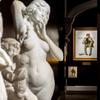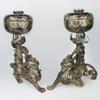A Star Rises Again: Bernard Buffet
- June 21, 2016 09:38
Like modern-day movie stars and celebs du jour, the art world is not without its fallen stars. Bernard Buffet (1928-1999) is one such figure, whose meteoric rise and resounding talent was overshadowed by his fall from grace. With a story as tragic as the melancholy subjects that dominate his canvasses, Buffet is a name that was largely forgotten in the annals of art history. Yet, as with most artistic greats, Buffet’s work has experienced a resurgence of interest following his recent death. The story of his rise, fall, and eventual resurrection remains one of the most compelling in all of art history.
Born in Paris, Buffet showed his talent at an early age and entered the Ecole Nationale des Beaux-Arts at 15. In an effort to save money as a young artist, he used very little paint on his canvases; thus, the stark, yet bold aesthetics of his distinctive style were born. Restrained to the point of depravation, his existential compositions mimicked the mood of post-WWII Paris, particularly the writings of Jean-Paul Sartre and Albert Camus, which were en vogue with contemporary youth. Very quickly, his work was heralded as the paradigm of post-war art.
His expressive style and avant-garde attitude brought him great fame and fortune at a relatively early stage in his career. In 1956, an average canvas for the artist could sell for £5,000; at the time, this was more than twice the amount paid for a middle-class home. In 1958, the first major retrospective of his work was held at the Galerie Charpentier in Paris – over 8,000 visitors were reported on its opening day. He appeared alongside Yves Saint Laurent, Brigitte Bardot, Roger Vadim and Francoise Sagan in a 1958 article in The New York Times Magazine titled “France's Fabulous Young Five.” He was lauded as France’s new Picasso, celebrated as the leading artist of his generation – all before the age of 30.
The fame and glamour of his 30s, however, would soon begin to fade. His work, though fashionable, had never earned high critical acclaim; the high art circles valued abstraction above all else, and Buffet’s oeuvre fell strictly in the realm of the figurative. The French art establishment turned against him, led primarily by Andre Malraux, the French Culture Minister, and Pablo Picasso himself. Yet, while his reputation seemingly fell into shambles in Paris, his work remained highly collected, particularly in Japan. To this day, two museums dedicated solely to his work exist there.
His death in 1999 led Western art historians to re-evaluate his oeuvre. Half a century removed from the pretension and prejudices that led to Buffet’s disgrace, collectors and critics have looked at Buffet with new eyes – and no longer find him lacking. A comprehensive retrospective of Buffet paintings was held in 2009 at the Musée de la Vielle Charité in Marseilles, with another planned for October 2016 at the Musee d'Art Moderne de la Ville in Paris. Today, his work can be found in the collections of the Tate Gallery in London, the Cincinnati Art Museum, the Centre Pompidou in Paris and the Brooklyn Museum of Art. The market has taken notice, and the demand for his work has skyrocketed in recent years. Once a shining star that became regarded as a charlatan, Buffet is finally receiving the recognition and acclaim he deserves – for being, quite simply, a great artist.
About M.S. Rau Antiques:
M.S. Rau Antiques has spent over 100 years earning the trust of discerning collectors world-wide. Located in the heart of New Orleans’ historic French Quarter, our peerless showroom houses one of the world’s most extensive and stunning collections of important fine art by artists such as Monet and de Kooning, 18th-and 19th-century antiques, and breathtaking jewelry, including rare colored diamonds.



















100x100_c.jpg)

